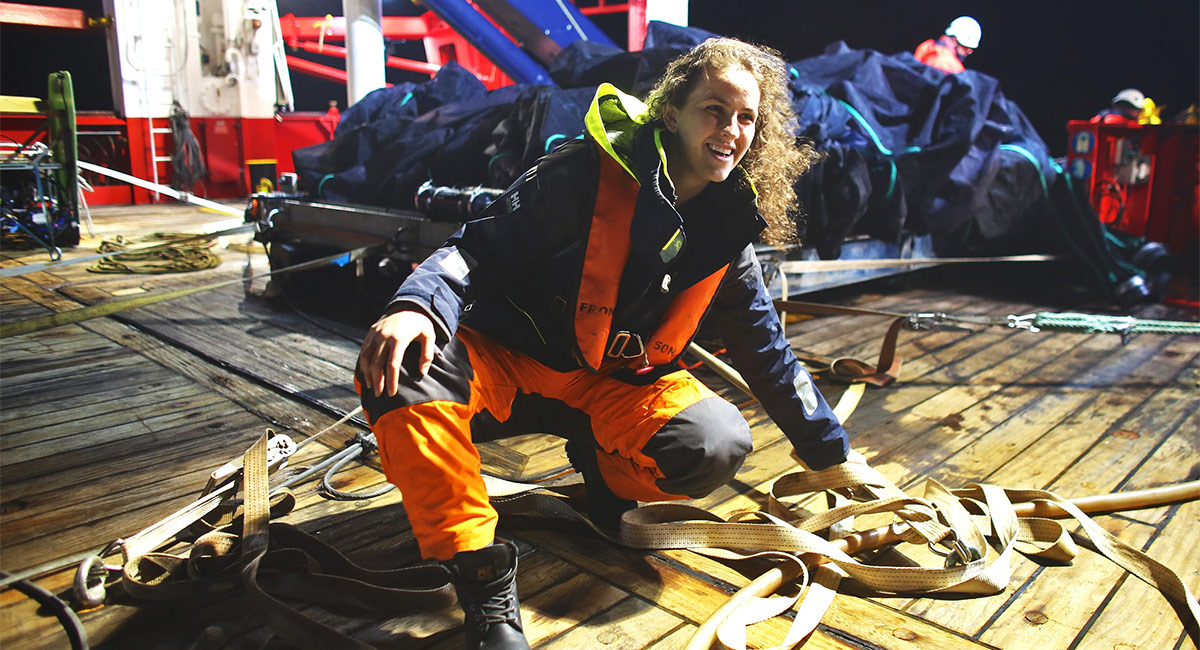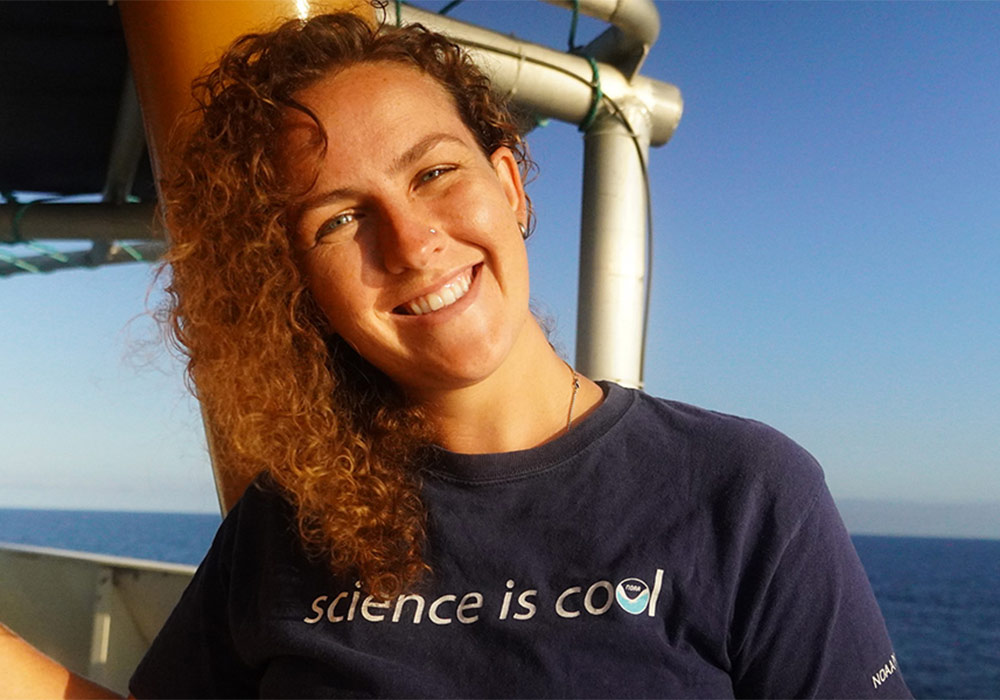Deep in the ocean, where the sunlight barely reaches, creatures thrive in a darkness unknown to most of us. Nearly a half-mile below the ocean’s surface lies an ecosystem of life – from microscopic to massive – which a team of marine scientists calls the “ocean twilight zone.” As part of this research team, South Carolina Honors College alumna Kayla Gardner, 2018 marine science, spent the last six years examining how this ecosystem impacts not only the entire ocean, but also the world above.
“The ocean twilight zone is an important source of food for many marine animals, but it also plays an important role in taking carbon out of the atmosphere, which helps to regulate the Earth’s climate,” said Gardner. “By learning more about the twilight zone, we want to encourage government leaders and policymakers to protect it.”
Gardner’s passion for protecting the ocean and teaching others to do the same led her to pursue a career in marine science. Unlike many young people who are drawn to dolphins, turtles or sharks, much smaller creatures sparked Gardner’s interest.
“Zooplankton and phytoplankton,” says Gardner with a laugh. “The summer after my junior year, I attended a camp for marine biology. The oceanographer leading the class said, ‘I hate dolphins. I love plankton. By the end of this, you will, too.’ We went out on research vessels and looked at zooplankton under the microscope for hours. She was right. I was hooked.”
Gardner, who attended high school in Tennessee, decided to pursue a degree in marine science and visited several universities before choosing USC.
“I received the McNair Scholarship, which was a tremendous amount of financial support. I was impressed with the resources of the South Carolina Honors College and the reputation of the university’s marine science education.”
Awarded to the top 20 out-of-state students entering the Honors College each year, the highly competitive McNair Scholarship provides tuition and additional money for academic endeavors outside the classroom. Gardner immediately took advantage of off-campus learning.
“McNair scholars are quickly introduced to faculty and their research,” Gardner says. “A few researchers, including Dr. Tammi Richardson, were surprised to see a freshman with more than surface-level research experience who had worked on a marine vessel. She offered me the opportunity to work in her lab.”
Richardson, the 2022 Michael J. Mungo Distinguished Professor of the Year, studies water quality, ecosystem health and phytoplankton in our waterways. Phytoplankton are single-celled organisms that help regulate the earth’s climate by performing photosynthesis in their tiny bodies.
“I filtered samples, maintained cultures and ran tests,” said Gardner. “Dr. Richardson also became a valuable mentor and advisor, and she supported me as I worked on a separate REU project focused on harmful algae blooms.”

Gardner received funding for a National Science Foundation Research Experience for Undergraduates, or NSF REU, with support of the Honors College. She spent three years researching alongside marine scientists at Mote Marine Laboratory in Sarasota, Florida.
“You may have seen or heard about red tides along the coast. They are caused when microscopic organisms, a type of harmful algae, overrun an area. At the time, we had little information on how harmful algae blooms (HABs) naturally terminate. During our research, I focused on unearthing these mechanisms to provide environmentally safe ways to control HABs. I discovered that several local species of macroalgae release compounds that reduce red tide populations.”
Gardner’s research and academic success brought her attention quickly. By her junior year, she earned the Ernest F. Hollings Undergraduate Scholarship and the Barry M. Goldwater Scholarship, each opening doors to more research opportunities.
“Hollings was probably my most formative fellowship and a truly phenomenal experience,” said Gardner.
Named after retired South Carolina Senator Ernest F. Hollings, the Hollings Scholarship Program exposes rising juniors and seniors to the mission of the National Oceanic and Atmospheric Administration (NOAA). Hollings scholars often become scientists, policymakers or educators who impact oceanic and atmospheric research and exploration.
“The scholarship included a summer internship with NOAA. I knew I wanted to explore something different, so I chose to travel to the Hawaii office to work with the education and outreach surrounding monk seals.”
"I think, as scientists, we must do better at expressing scientific concepts in a way that people can understand and explaining why they should care.”
Gardner collected relevant resources that teachers, local lawmakers, librarians, activists and others were using to educate and make policy decisions, then created a publicly accessible online database to house the information. The experience led her to realize her future career path.
“(A) straight academic path as a professor wasn’t for me. I want to engage with the public. I think, as scientists, we must do better at expressing scientific concepts in a way that people can understand and explaining why they should care,” said Gardner.
Gardner credits the fellowships with enhancing her research experiences and making her a more competitive candidate for graduate schools and the workforce.
“I recognize and truly appreciate how amazing the scholarship money can be for students. The scholarships allow students to have research experiences without having to get second jobs,” said Gardner. “But for me, they also offered valuable exposure to various aspects of marine science, which helped me decide which career I wanted to pursue and where I wanted to go to earn my Ph.D.”
Gardner will soon earn her doctoral degree from the prestigious Massachusetts Institute of Technology/Woods Hole Oceanographic Institution Joint Program in Oceanography and Applied Ocean Science and Engineering. While in it, she’s found herself looking back through the microscope at the creatures that first made her fall in love with marine science as a teen.
“We still examine zooplankton and phytoplankton, as we study how carbon moves through the food webs. But, I mostly look at samples of muscle tissue from fish in the twilight zone and use a biochemical method to figure out where they’re getting their food.”
The expansive ecosystem’s challenges from above include the threat of commercial fishing and global climate change. Gardner hopes the team’s research helps to better inform policy makers on how they can use the ocean’s resources while protecting marine life and our environment.
Now Gardner faces her next adventure — the start of her career.
“I was recently hired as an oceanography faculty for an immersive marine science camp for high schoolers through SEA, the Sea Education Association. I love sharing marine science with young people, maybe sparking their passion for conservation. I also hope to gain additional field work experience on Arctic or Antarctic research vessels in the fall. That’s an area I’ve never explored. I’m excited about the opportunities ahead of me.”
Opportunities abound for Gardner thanks to years of hard-work and innovation in the classroom, lab and oceans around the world.
How they do it
Students applying for national fellowships and scholarships work closely with top research faculty members. Students interested in applying for national fellowships should contact National Fellowships and Scholar Programs.
